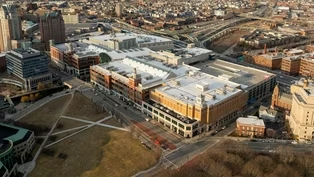
Providence, Florence, Floods
Clip: Season 4 Episode 2 | 6m 48sVideo has Closed Captions
Learn about the history of documentary photography.
This week on Art Inc, we explore the history of documentary photography through the lens of climate change—highlighting how photographers over the years have captured the evolving environment and documented pivotal moments in our changing world.
Problems playing video? | Closed Captioning Feedback
Problems playing video? | Closed Captioning Feedback
Art Inc. is a local public television program presented by Ocean State Media

Providence, Florence, Floods
Clip: Season 4 Episode 2 | 6m 48sVideo has Closed Captions
This week on Art Inc, we explore the history of documentary photography through the lens of climate change—highlighting how photographers over the years have captured the evolving environment and documented pivotal moments in our changing world.
Problems playing video? | Closed Captioning Feedback
How to Watch Art Inc.
Art Inc. is available to stream on pbs.org and the free PBS App, available on iPhone, Apple TV, Android TV, Android smartphones, Amazon Fire TV, Amazon Fire Tablet, Roku, Samsung Smart TV, and Vizio.
Providing Support for PBS.org
Learn Moreabout PBS online sponsorshipnine, eight, seven, six, five, four, three, two, one, zero.
Ignition.
Liftoff.
(rocket roaring) Liftoff.
(flag flapping) - There is a NASA astronaut named Nicole Stott, and she wrote a terrific book, and she talks about spending a great deal of time circling the Earth at the International Space Station.
And the key line in the book, and really the theme of the book, is we went into space to discover the Earth.
So beautiful photographs that are taken by the astronauts who are orbiting really tell us a lot about how the environment is changing.
So I think that is a really huge value to everyone, in every country, to see how things are changing.
And it's really our collective responsibility to be aware of that and to see what we can do about it.
(dynamic jazzy orchestral music) "What we do as journalists is create a first draft of history."
So Lewis Hine was really one of the early and most famous documentary photographers.
It was because of him that photojournalist really had a path to follow, as far as what they did and why they did it.
So the documentary work that he did, particularly when it came to children working in mills, and some of the work he did was in New York and through New England, it really showed people who were newspaper readers, the dangers involved in, you know, the type of work that was being done, and it showed how things needed to be changed.
(paper rasping) (intriguing orchestral music) - Looks great.
Young man.
- Yeah, yeah.
- Look at that.
- The Providence Journal reached out to me, I was recently retired, and they said, "We have a big project and we thought of you, would you like to do it?
And I did, and I got connected with Joyce Acciaioli Rudge, who is a person here in Rhode Island, she's done other projects like Splendor of Florence previously.
- So we are surrounded with the most amazing vintage photographs from the Providence Hurricane Carol in 1954, and the Great Flood of Florence in 1966.
I had access to the David Lee's archives because I have shown his photographs in exhibit before.
So putting the two together just worked.
and people are really enjoying it.
So it shows that there is life after tragedy, that there is restoration that can take place.
- Art conservation is the preservation and conservation, keeping it the way that it is, or if it's damaged, trying to fix that damage.
(mellow orchestral music) - So this is a Speed Graphic camera, the type that Providence Journal photographers used in the 1950s to document Hurricane Carol.
So it was only one picture at a time, and it was challenging for those photographers to actually be out there in that kind of weather, making the photographs that you saw as part of our exhibit.
- These photographs tell the story, these photographs are gonna let people see, you know, the way Kennedy Plaza looked underwater, and all of these department stores that are no longer here, but, you know, you can see how Westminster Street and Boston Street, how they all looked back in 1954.
(page rasping) - The Providence Journal photographers have been covering and documenting life in Rhode Island for almost 150 years.
(page rasping) The oldest photos in the photo file at the Journal, which is about a million, and that's an accurate number, a million individual photos, extend back to the 19th century.
And our publisher at the time, Janet Hasson, called me in and said, "How would you feel about doing a book?"
And I said, "I think it would be terrific."
And she asked me one question, she said, "Is it gonna be good?"
And I said, "Oh, it'll be good."
So the first volume of "Rhode Island Memories" really started from the 19th century and went to 1939, and it became very popular.
And, immediately, they signed me on to do two more volumes, Volumes II and III, the '40s, '50s, and up to 1999.
It was a terrific way of showing to the people of Rhode Island, their history, their family history, places that not only they've gone, but maybe their ancestors, their parents or grandparents have gone.
(waves crashing) (mellow orchestral music) I like to think that now, the fact that we've saved that material, and a hundred years, a thousand years from now, maybe, historians will look back and say, "This is how people lived, and it was a valuable document to see that work."
(mellow intriguing orchestral music) (mellow intriguing orchestral music continues) When I was in Miami, I had the honor of meeting Astronaut Frank Borman.
He was the commander of Apollo 8, which was in December of 1968, I was a kid in school at the time.
What was really memorable about that flight was the photograph that was taken by one of the crew members, Bill Anders, and it was on the cover of Life magazine.
And the word iconic, I think is used a little too much these days, but it really was an iconic photograph of the crescent Earth hanging in space with the lunar horizon in the foreground.
Frank Borman said to me, "It really made us aware of how tiny the Earth is in terms of the universe."
And that photograph, in particular, makes the Earth look like a beautiful blue and white Christmas ball.
And so, that's something very special, and it should be special to all of us, and be aware of the fact that we're here to preserve the Earth.
(waves crashing) (intriguing orchestral music) (static crackling) (static whirring) - [Narrator] Thanks for watching,
Video has Closed Captions
Clip: S4 Ep2 | 6m 42s | Explore themes of artist housing displacement through Michael Townsend's unique view. (6m 42s)
Video has Closed Captions
Clip: S4 Ep2 | 8m 47s | In Providence, a small number of its Brutalist Buildings are still standing. (8m 47s)
Providing Support for PBS.org
Learn Moreabout PBS online sponsorship

- Arts and Music

Innovative musicians from every genre perform live in the longest-running music series.












Support for PBS provided by:
Art Inc. is a local public television program presented by Ocean State Media


